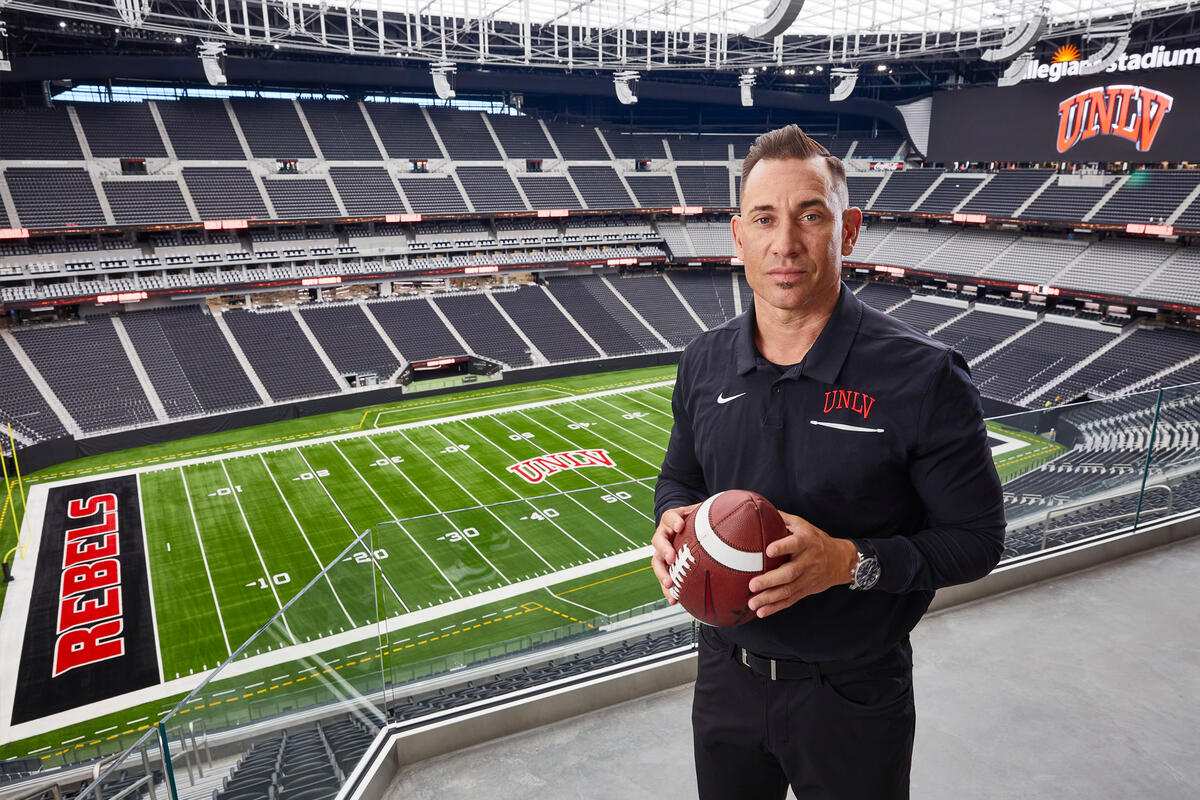UNLV football's 53rd season was always going to be an inflection point for the program. A brand-new stadium, an all-new coaching staff, and even shiny new uniforms..
Then came the practice uncertainty, stop-and-start season schedule, and novel coronavirus that caught newly minted head coach Marcus Arroyo — along with everybody else — off-guard.
In an already Darwinian game, this is the peak of Darwinian seasons: to survive, adapt.
"It took a minute for us to understand," Arroyo said. "What we learned quickly was we had to accept that what was normal programming for what we do in our daily life — in our daily program as football coaches — it's gone."
X's and oh-no's
Normalcy may have never been in Arroyo’s cards — new head coaches don't typically pull double duty for their old teams and new.
Arroyo's hiring was announced in December, before he headed to the Rose Bowl. The Oregon Ducks, where Arroyo had coached since 2017 and most recently as offensive coordinator and quarterbacks coach, were facing the Wisconsin Badgers on New Years' Day. That would be a defining game in any coach's career.
Arroyo's offense made sure he went out with a bang — including bowl MVP quarterback Justin Herbert, who would become a rookie sensation mere months later as the new starter in Los Angeles. The Ducks ultimately prevailed in a 28-27 nailbiter over Wisconsin, all while Arroyo was preparing to take over the Rebels program.
With the Ducks ensconced as Rose Bowl winners, Arroyo jumped into the recruiting fray in early January, bringing 28 recruits into the Rebel fold within a month.
What he didn't know was there were fewer than six weeks before pandemic shutdowns would sweep across the country, upending the meticulous routine and clockwork precision of a college football season.
"We got called back home and out of the office the first week we were going to spring ball," Arroyo said. "To teach the way we knew wasn't happening anymore. It only took me a couple of days before I quickly pivoted. We can't meet in person. We can't go on the field. What are the alternatives? So here comes Zoom. Here comes online teaching; here comes every app, every tool I can research. Looms and zooms and Google Docs. Everything we could do, we used."
Making a quick pivot wasn't new territory to the first-year coach. Hired as the Tampa Bay Buccaneers' quarterbacks coach in 2014, he found himself stepping up to fill in for offensive coordinator Jeff Tedford, who for medical reasons was forced to pull back from the Bucs before the season started.
Adapting to a new role as a key member of a coaching staff while under the bright lights of Soldier Field and the Superdome would instill in anyone a sangfroid about the unknown.
"You can still be 0-1 and really win," he said. "You have a better patience. You have a better form of communication. You have a better understanding. You learn a ton."

The disruptions of the pandemic, then, were just one more obstacle to reorient around. Arroyo started by sending out daily schedules for players to follow — listing times to wake up, when and how to work out, what to eat, when to take a break.
He studied the early returns on the current NFL season and saw a rash of injuries across the league in the early going. He looked at other sports — how their seasons had been canceled, how teams adapted, how they balanced the need to bring players along in practice at a natural pace versus a compressed time frame to returning to full play. He used GPS tracking to study movement and loads and stresses on players to find out who was out of gas and who could be pushed harder.
But beyond the nuts-and-bolts of ensuring players stayed on point in their workouts and nutrition routines, Arroyo used the pause to lean into the one arena where it was still viable to fully commit: deepening team bonds and addressing the mental aspects of life as a student athlete.
Arroyo held what he called the coaches' dinner table at night, where players and coaches from different position groups mixed together in online videoconferences. The first order of business: talk about anything other than football for 40 minutes.
Players opened up about personal issues, about the pandemic, about mental health, about where they come from and how it shaped them. The summer's national racial reckoning was a touchstone.
"Normal programming is gone, but the approach to be a good person and good human isn't," Arroyo said. "We got to know a lot about ourselves and a lot about what we believed in as a program. I think like many of us, [the student athletes] were probably apprehensive to try it. You're not inclined to just trust people. That's got to be earned by the coaches by having a really, really hard conversation. You have to be authentic and relatable and strip yourself down and take some ownership of some things."
The Hail Mary connects
The Big 10 and Pac-12, two of college football's five dominant conferences, halted fall sports in August, days after the Mountain West had done the same. The clouds never seem to fully part in 2020, but gloom gave way to a mere light haze on Sept. 16 when the Big 10 voted to resume play. A week later, the Pac-12 signaled its return.
As he watched seasons start in other parts of the country, Arroyo didn't get his hopes up. California and Hawaii had stricter coronavirus measures than elsewhere, and that impacted the Mountain West. He focused instead on the things it was in his power to control, wary of the crushing effect optimism-turned-disappointment would have on morale if the conference flirted with returning to play then decided against it.
A day after the Pac-12 announced it would resume, though, the Mountain West did too. Finally, practice could move forward.
"It was like Christmas," Arroyo said. "We've been calling it our 'program plasticity,' the ability for us to reshape and mold and bend and sacrifice and be creative. The kids were ultra excited.
“We're focused on making sure that we're going back into this thing really smart, because there's a whole other can of worms. You got to think about how are they going to eat? We've got to have our masks up. How do we space them out? How do we eliminate one sideline? How do we space out tables?"
On Oct. 24, the 2020 UNLV football season will begin. Finally. San Diego State hosts the Rebels in Southern California.
A week later, on Halloween, UNR invades Allegiant Stadium. The first UNLV home game will come against its deepest rival. The Fremont Cannon, captured by the Rebels in a November that feels like two lifetimes ago, will again be up for grabs. This time in a multibillion-dollar stadium, led by a coach whose most recent game was a Rose Bowl win.
There will be gratitude Arroyo said when he steps on the field — gratitude for everyone behind the scenes and everyone in Las Vegas who helped make the season possible against the backdrop of the pandemic. But he also knows that for the difficulties, the team has been given a gift, too. One that comes from those dinnertime conversations that forged into discomfiting territory.
"Those conversations down those avenues were hard, but that's meaningful," Arroyo said. "You end up learning about each other and trusting each other. And when you get out between the lines and you get out into an environment that calls for some toughness, both mentally and physically, we can lean into each other a little bit more and, and trust each other and ask for help and not be afraid to be wrong or to be humbled."



